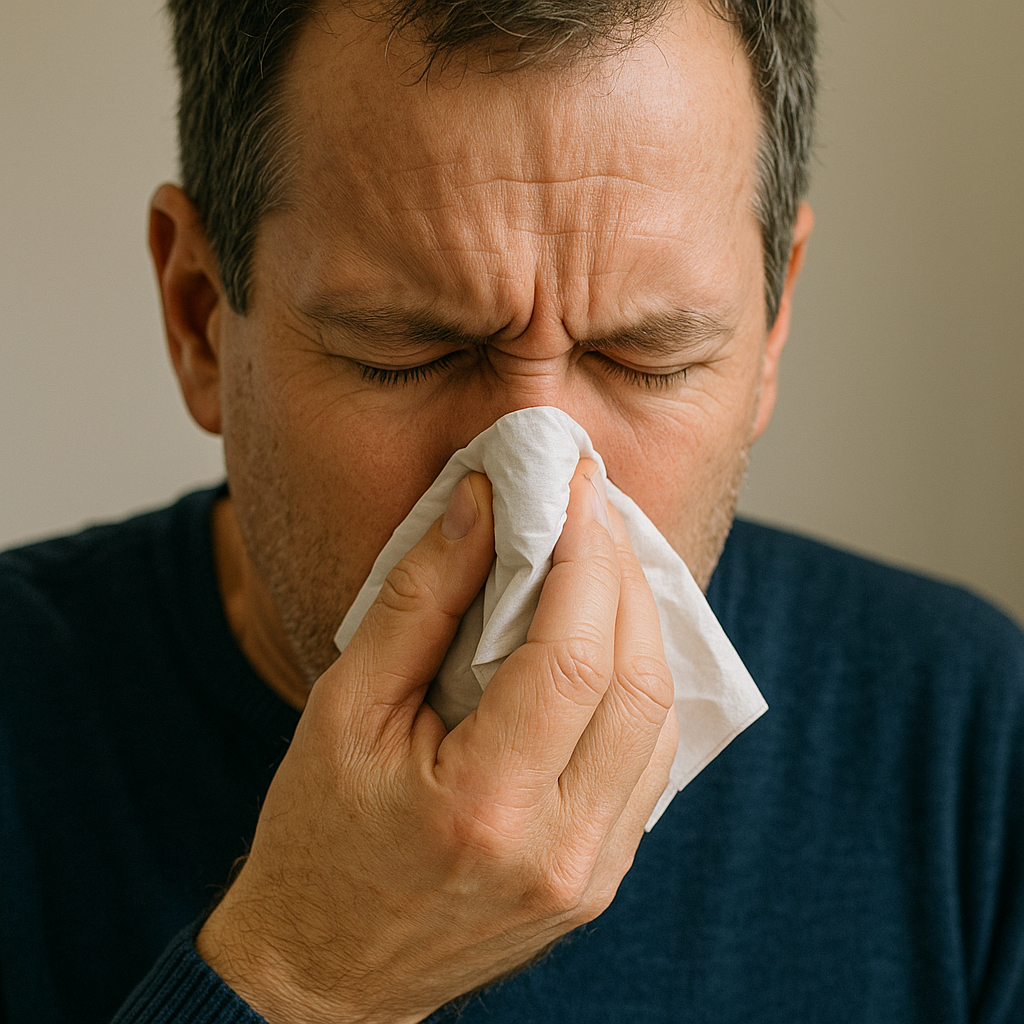We’ve all had it—waking up with a nose that just won’t stop dripping, leaving you reaching for tissues all day. A runny nose, medically called rhinorrhea, isn’t a disease on its own. Instead, it’s your body’s way of saying, “Hey, something’s not quite right.”
But what exactly causes it? Is it always due to a cold? Can it be serious? Let’s dig in.
What is a Runny Nose?
A runny nose is the continuous drainage of mucus from the nostrils. It can be watery, thick, clear, yellow, or green—depending on what’s going on inside your nasal passages.
This is one of the most common symptoms seen across the world. According to global health data, almost every person will experience multiple episodes of rhinorrhea each year, especially during colder months or allergy seasons.
How Does It Happen?
Your nose is like an air filter. It warms, humidifies, and cleans the air before it reaches your lungs. To do this, it produces mucus—a sticky substance that traps dust, germs, and pollen.
When your nose is irritated (by a virus, allergen, or something else), it reacts by overproducing mucus. Think of it like turning on a faucet full blast to flush out a sink. Your body’s goal? Clear out the irritants fast.
Here’s what typically happens:
- Blood vessels in your nose swell due to inflammation.
- Mucous glands become overactive.
- Mucus drains out the front (runny nose) or back (post-nasal drip).
What Causes a Runny Nose?
So why does your nose turn into a leaky faucet? Here are the main culprits:
1. Viral Infections (Like the Common Cold)
About 40–50% of runny nose cases are due to viral upper respiratory infections. The rhinovirus is the most common one.
You may also have sneezing, sore throat, or mild fever.
2. Allergic Rhinitis (Hay Fever)
Allergies affect up to 30% of adults and 40% of children worldwide.
When you’re allergic to something like pollen, dust, or pet dander, your immune system goes into overdrive—histamine is released, causing sneezing, itching, and lots of clear mucus.
3. Sinusitis (Sinus Infection)
This causes inflammation of the sinuses. It often starts with a cold but lingers longer.
Mucus becomes thick and yellow or green, and you may feel facial pain or pressure.
4. Cold Weather or Dry Air
Ever noticed your nose runs more when it’s cold outside? That’s because cold air dries out your nasal passages, prompting your nose to make more mucus to stay moist.
5. Irritants like Smoke or Perfume
Strong smells, smoke, or even spicy food can irritate your nasal lining, triggering temporary rhinorrhea.
6. Hormonal Changes
Pregnancy, menstruation, and certain birth control pills can cause a runny nose due to increased blood flow to the nasal passages.
7. Medications (Drug-Induced Rhinitis)
Overusing nasal decongestant sprays (like oxymetazoline) can actually worsen your runny nose over time—a condition known as rebound congestion.
Risk Factors
Who’s more likely to deal with a runny nose?
Anyone can get it, but some people are more prone.
- Children – Their immune systems are still developing, so they catch more colds.
- Allergy sufferers – Especially those with a family history of allergies or asthma.
- Smokers – Smoke irritates nasal passages.
- Healthcare workers and teachers – Constant exposure to sick people increases risk.
Other Symptoms That May Come with It
A runny nose rarely comes alone. Here’s what may show up alongside:
- Sneezing and nasal congestion – Common with colds and allergies.
- Itchy eyes – A classic allergy symptom.
- Cough – Often due to post-nasal drip.
- Headache and facial pain – Could mean sinusitis.
If the mucus turns yellow or green and lasts more than 10 days, it may be a bacterial infection rather than a simple cold.
How Doctors Identify the Cause
In most cases, doctors rely on history and symptoms to make a diagnosis. But if your symptoms last more than 10 days or come with high fever or facial pain, further tests may be needed.
Gold standard test for allergies:
- Skin prick test or blood test (IgE) – Helps identify specific allergens.
For chronic or unclear cases:
- Nasal endoscopy – A tiny camera checks inside your nose and sinuses.
- CT scan – Can reveal structural issues like a deviated septum or sinus blockage.
Treatment for a Runny Nose
For mild cases, your nose often clears up on its own. But if you want relief:
First-line treatment :
- Antihistamines – Best for allergy-related runny noses. Non-drowsy options include cetirizine or loratadine.
Other options:
- Saline nasal sprays – Flush out irritants and moisturise nasal lining.
- Nasal corticosteroids (e.g., fluticasone) – Reduce inflammation, especially for allergic rhinitis.
- Decongestants (e.g., pseudoephedrine) – Relieve swelling short-term, but don’t use for more than 3 days in a row.
- Steam inhalation – Helps thin mucus and ease breathing.
If symptoms are from a bacterial sinus infection, a doctor may prescribe antibiotics—but only if necessary.
When to See a Doctor
Get checked if:
- Runny nose lasts longer than 10–14 days.
- You have high fever, severe facial pain, or swelling.
- Mucus is thick, discoloured, and persistent.
- It interferes with sleep or daily life.
Final Thoughts
A runny nose is annoying, but it’s usually harmless—and often a sign your body is doing its job. Whether it’s allergies, a cold, or irritants, knowing the cause can help you get the right treatment faster.
Next time your nose starts dripping, ask yourself: Is this just a cold… or is my body reacting to something else?
References
- “Rhinitis and Rhinosinusitis.” American Academy of Otolaryngology–Head and Neck Surgery. https://www.entnet.org/resource/rhinitis-and-rhinosinusitis/
- “Common Cold.” Mayo Clinic, 2024. https://www.mayoclinic.org/diseases-conditions/common-cold
- “Allergic Rhinitis.” Cleveland Clinic, 2023. https://my.clevelandclinic.org/health/diseases/8610-allergic-rhinitis
- “Nonallergic Rhinitis.” National Institute of Allergy and Infectious Diseases (NIAID). https://www.niaid.nih.gov/diseases-conditions/nonallergic-rhinitis

